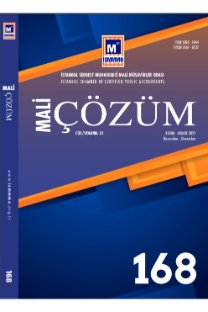İnşaat sözleşmeleri muhasebesi ve finansal performansın ölçülmesinde maliyeti kurtarma yöntemi
Yıllara yaygın inşaat taahhütlerinin muhasebeleştirilmesindeki temel sorun, inşaat gelir ve maliyetlerinin dönemler itibari ile dağıtılmasıdır. 11 Nolu Türkiye Muhasebe Standardı (TMS) inşaat sözleşmesinin sonucunun güvenilir biçimde öngörülebildiği durumda tamamlanma yüzdesi yöntemi kullanılmasını gerekli kılmıştır. Ayrıca standart, inşaat sözleşmesi sonucunun güvenilir biçimde tahmin edilememesi durumunda; sadece katlanılmış sözleşme maliyetlerinin geri kazanılabilmesi muhtemel olan kısmı kadar gelir kaydedilmesi gerektiğini, sözleşme maliyetlerinin oluştukları dönemin gideri olarak finansal tablolara yansıtılması gerektiğini ve sözleşme sonucu güvenilir biçimde tahmin edilemediğinden kâr tahakkuk ettirilmemesi gerektiğini belirtmiştir. Bu yaklaşım, Amerikan Genel Kabul Görmüş Muhasebe İlkelerinde (USGAAP) hasılatın tahakkuk ettirilmesinde kullanılan maliyeti kurtarma yöntemine benzemektedir. Bu çalışmanın amacı TMS 11e uygun olarak maliyeti kurtarma yönteminin inşaat sözleşmesinde uygulanması konusunda öneri sunmaktır. Çalışmada ayrıca tamamlanma yüzdesi yöntemi, maliyeti kurtarma yöntemi ve tamamlanmış taahhüt yöntemi arasındaki farklar bir örnek yardımı ile açıklanmış ve yöntemler karşılaştırılmıştır.
Accounting for construction contracts and cost recovery method for measuring financial performance
The main problem in the accounting for construction contracts is the allocation of contract revenue and cost to the accounting periods in the building activity is performed. IAS 11 requires the use of percentage of completion method when the result of a construction contract can be estimated reliably. On the other hand, when the outcome of a construction contract cannot be estimated reliably revenue should be recognized in the income statement only to the extent that is likely to recover costs incurred because of the contract, and the costs of the contract should be recognized as an expense in the year they are incurred. The second approach is similar to cost recovery method which is used for recognition of revenue under USGAAP. The purpose of this study is to recommend application of cost recovery method to construction contructs in conformity with IAS 11. Additionally, the study aims to provide comparative analysis of percentage of completion method, cost recovery method and completed contract method with the help of a case.
___
- Accounting Principles Board (APB) (1966). Opinions of the Accounting Principles Board No.10 http://clio.lib.olemiss.edu/cdm4/document. php?CISOROOT=/aicpa&CISOPTR=149&CISOSHOW=138, [erişim tarihi: 12 Aralık 2011].
- Alagöz, Ali (2009). TMS:11 İnşaat Sözleşmeleri Standardı Çerçevesinde İnşaat İşlerinde Sözleşme Maliyet ve Gelirlerinin Muhasebeleştirilmesi Muhasebe ve Vergi Uygulamaları Dergisi.1(2009):1-38.
- Bidgoli, Hossein (2010). The handbook of Technology Management: Supply Chain Management, Marketing and Advertising, and Global Management. 2.bs. New Jersey: John Wiley & Sons,
- Bragg, Steven M.(2010). Revenue Recognition: Rules and Scenarios. New Jersey : John Wiley & Sons.
- Bragg, Steven M. (2011). GAAP 2012: Interpretation and Application of Generally Accepted Accounting Principles. 10.bs. New Jersey : John Wiley & Sons.
- Carmichael, D.R., Whittington, O. Ray ve Lynford, Graham. (2007). Accountants Handbook: Special Industries and Special Topics. New Jersey : John Wiley & Sons.
- Financial Accounting Standards Board (FASB) (1981). Statement of Financial Accounting Standards No.45, Accounting for Franchise Fee Revenue http://www.fasb.org/cs/BlobServer?blobcol=urldata&blob table=MungoBlobs&blobkey=id&blobwhere=1175820905033&blobhead er=application%2Fpdf, [erişim tarihi: 9 Kasım 2011].
- Financial Accounting Standards Board (FASB) (1982). Statement No.66, Accounting for Sales of Real Estate http://www.fasb.org/summary/ stsum66.shtml, [erişim tarihi: 9 Kasım 2011].
- Financial Accounting Standards Board (FASB) (2007). Comments on Exposure Draft: Proposed Statement of Financial Accounting Standards, Accounting for Financial Guarantee Insurance Contracts, an interpretation of FASB Statement No.60; File Reference No. 1530-100. http://www. fasb.org/cs/BlobServer?blobcol=urldata&blobtable=MungoBlobs&blob key=id&blobwhere=1175818334683&blobheader=application%2Fpdf, [erişim tarihi: 9 Kasım 2011]..
- Güngörmüş, Ali Haydar ve Boyar, Ender (2007). TMS 11 İnşaat Sözleşmeleri Standardında Maliyet Güncellemesi (Eskalasyon) Durumunda Gelirin Tespiti Vergi Dünyası.311 (2007): 107-110.
- Hellman, Niclas (2008). Accounting Conservatism under IFRS Accounting in Europe. 5, 2 (2008) : 71-100.
- Kieso, E. Donald., Weygandt, Jerry J. ve Warfield, Terry D. (2010). Intermediate Accounting IFRS Edition, USA:John Wiley & Sons.
- Maç, Nazlı (2006). İnşaat Sektör Analizi http://www.kto.org.tr/d/file/ insaat-sektoru-2006.doc, [erişim tarihi:12 Nisan 2012].
- Nikolai, Loren .A., Bazley, John D. ve Jones, P. Jefferson (2010). Intermediate Accounting. 11. bs. USA: South Western Cengage Learning.
- Palmer, William J., Coombs, William E. ve Smith, Mark A. (1994). Construction Acocunting and Financial Management, 5. bs. New York: McGraw Hill.
- Sayarı, Mehmet (2010). İnşaat Taahhüt Sözleşmelerinin Muhasebeleştirilmesi Türkiye Birinci Muhasebe Uygulamaları Sempozyumu, Kayseride sunulan bildiri. http://www.tmsk.org.tr/makaleler/TMS%2011/ InsaatTaahhut.doc, [erişim tarihi: 9 Kasım 2011].
- Siegel, Joel G. ve Shim, Jae K. (2006). Accounting Handbook. 4bs. Barrons Educational Series.
- Stickney, Clyde P. [ve öte.] (2010). Financial Accounting: an Intro duction to Concepts, Methods and Uses. South Western Cengage Learning.
- Sümer Göğüş, Handan (2006). Yıllara Yaygın İnşaat ve Onarım İşlerinin Muhasebeleştirilmesinde Kullanılan Yöntemler, Muhasebe ve Denetime Bakış.19 (2006): 75-86.
- T.C. Yasalar (31.12.1960) Gelir Vergisi Kanunu. Ankara : Resmi Gazete (10700 sayılı)
- Türkiye Muhasebe Standardı (TMS) 8: Muhasebe Politikaları, Muhasebe Tahminlerinde Değişiklikler ve Hatalar. [y.y.] : [yayl.y.]
- Türkiye Muhasebe Standardı (TMS) 11: İnşaat Sözleşmeleri. [y.y.] : [yayl.y.]
- Türkiye Muhasebe Standardı (TMS) 18: Hasılat. [y.y.] : [yayl.y.]
- Türkiye Muhasebe Standardı (TMS) 23: Borçlanma Maliyetleri. [y.y.] : [yayl.y.]
- Wahlen, James W. Ve ötekiler (2010). Financial Reporting, Financial Statement Analysis and Valuation: A Strategic Perspective. 7.bs. USA: South Western Cengage Learning.
- Williams, Jan R. ve Carcello, Joseph V. (2008). GAAP Guide Level A: Restatement&Analysis of Current FASB Standards, USA:CCH.
- Yargıç, Bora (2004). Yıllara Sari İnşaat ve Onarım İşleri ve Muhasebeleştirilmesi, Mali Çözüm. 68 (2004):177-186.
- Yereli, Ayşe N. Kayalı, Nilgün ve Demirlioğlu, Lale (2011). İnşaat Sözleşmelerine İlişkin Türkiye Muhasebe Standardı (TMS 11) Çerçevesinde Yıllara Yaygın İnşaat Taahhüt İşlerinin Muhasebeleştirilmesi, Dokuz Eylül Üniversitesi Sosyal Bilimler Enstitüsü Dergisi, 13, 3 (2011): 113- 135.
- Yılmaz, Fatih (2009). TMS-11 İnşaat Sözleşmeleri Standardının İşletmeler Üzerindeki Etkisi: İMKBde Hisse Senetleri İşlem Gören Bir İnşaat Şirketi Yönetim.64 (2009): 8-26.
- ISSN: 1303-5444
- Yayın Aralığı: Yılda 6 Sayı
- Başlangıç: 1991
- Yayıncı: İstanbul Serbest Muhasebeci Mali Müşavirler Odası
Sayıdaki Diğer Makaleler
Muhasebede ihtiyatlılık kavramı ve temelleri
Muhasebe hilelerınin önlenmesi ve ortaya Çıkarılmasında kullanılan geleneksel araç ve yöntemler
CANOL KANDEMİR, ŞENOL KANDEMİR
İnşaat sözleşmeleri muhasebesi ve finansal performansın ölçülmesinde maliyeti kurtarma yöntemi
Şirket birleşme ve devralma kararlarının hisse senedi getirilerine etkisi
HAFİZE MEDER ÇAKIR, ZEHRA GÜLCAN
Bilanço tarihinden sonra ortaya çıkan satış iadeleri ile ilgili finansal raporlama yaklaşımları
